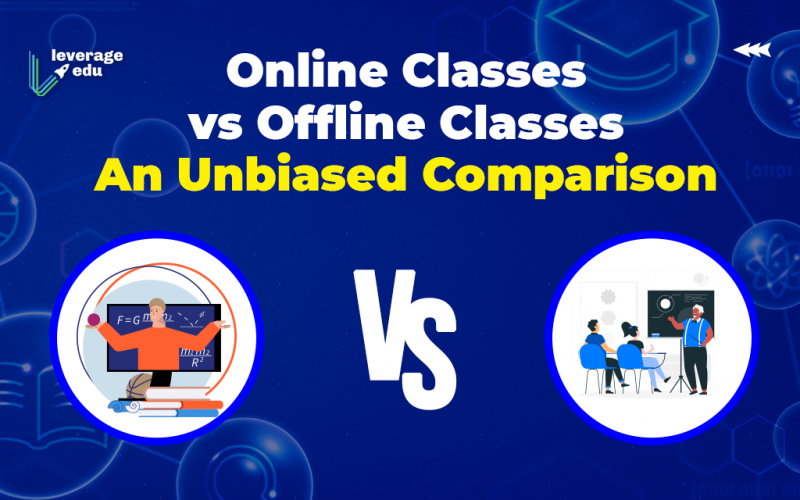


The Covid-19 pandemic brought a dynamic shift in the world education system. The imposition of lockdown led to the shutdown of physical classrooms and thus online education became the new norm. Although online learning has managed to keep education alive in these difficult times, it cannot completely replace it. Both online and offline education have their own set of advantages and disadvantages. In this blog, we will explore one of the most debated topics these days, online classes vs offline classes.
THIS BLOG INCLUDES:
Also Read: Are Online Classes Becoming the New Normal?
Online Education
With the emergence of technology, the method of delivering education has forever changed. As a matter of fact, online education has become a flexible instructional method of teaching wherein students can easily gain access to study material in the comfort of their homes. Moreover, online education provides an excellent opportunity for students who are unable to enrol in traditional classrooms as well as supports students in setting their own pace for studying.

Online education helps in inculcating the habit of self-discipline and time management within students and provides them access to an unlimited number of educational resources. The students can easily set their own pace of learning as long as they have the right equipment and access to a proper internet connection.
Also Read: Online Education in India
Offline Education
Offline education is the traditional counterpart to online education and the original method of learning that allows students to have regular face-to-face interactions with their peers and teachers. As much as online education is predicted to be the future of learning, it cannot replace the holistic aspect of offline education.

Moreover, offline education also allows teachers to monitor the responses and behaviour of their students and accordingly address them as and when required. Hence, no matter how advanced online education is, offline education will continue to play a vital role in the development of students.
Online Education vs Offline Education
While online education is not a new phenomenon, its importance came to light after the pandemic. Given below is a table that highlights the main differences between online education vs offline education.
| Particulars | Online Education | Offline Education |
| Method of Teaching | Digitalised tools and methods of teaching | Traditional tools and methods of teaching |
| Cost and Time | Cost-effective and time-saving | More expensive than online education and consumes more time |
| Location | Virtual classrooms | Physical classrooms |
| Flexibility | Online classes have a flexible schedule | Offline classes have a fixed and strict schedule |
| Communication | Communication and collaboration happen digitally | Communications and collaborations happen face-to-face |
| Type of Approach | Facilitation and asynchronous approach | Instructional and synchronous approach |
| Pace of Learning | Students largely determine the pace of learning | Teachers largely determine the pace of learning |
| Level of Commitment | Students are less likely to remain serious and committed to their studies | Students remain more serious and committed to their studies |
Mode of Education in Offline and Online Classes
When it comes to online classes, teachers can easily educate their students via virtual classrooms. Students can easily access learning materials from anywhere as long as they have proper access to an internet connection. Online classes provide teachers with a number of online learning tools including videos, audio, animations, virtual whiteboards, virtual conference rooms and live chats with the students.
On the other hand, offline classes provide students with a practical learning environment within the walls of a physical classroom. It allows students to closely interact with their teachers as well as participate actively in live discussions and debates. Students can also participate in recreational activities like art and physical education which contributes to the overall mental and physical development of the student.
Accessibility
One of the greatest advantages of online classes is their accessibility from anywhere around the world. Students can simply log in from anywhere and gain access to learning material from the convenience of their homes. Apps like Zoom and Microsoft Team have allowed students to easily attend their lectures without having to leave the safety of their homes. Hence, online classes provide the distinct advantage of location flexibility.
However, offline classes require students to travel to the location of their educational institution. Teaching takes place in a fixed location which would typically comprise a lecture hall or a physical classroom. Certain students may need to travel far to reach their respective educational institutions and this may cause a great deal of inconvenience.
Time Management
Students who attend online classes are faced with the big challenge of time management. Online learners are typically distracted by a multitude of tasks and they lack a proper schedule. Since online classes provide the advantage of self-paced learning, students may not have a proper schedule and may succumb to the habit of procrastination. Moreover, students are required to stay logged in to their online classes for an extended period of time which may lead to students surfing the web for distractions or checking their social media pages.
In the case of offline classes, students have to adhere to a strict schedule that has been set up by the teachers. Furthermore, since there is synchronous learning, students will be required to complete their work and projects in a timely manner.
Flexibility of Classes
The flexibility of classes is the main highlight of online classes. It allows students to set their own learning pace without any additional pressure. Since students have access to recorded videos and online reading material, they can easily attend lectures as and when it is convenient. It also gives students more time to digest the study material and complete their work or research at their pace.
There is a certain amount of rigidity when it comes to offline education. Students are required to attend their lectures or sessions on time since there are no pre-recorded videos or notes that are easily available to the students. Hence, students are required to follow a predetermined and strict schedule as set by their educational institute.
Student-Teacher Interaction
Contrary to the popular belief that there is hardly any interaction between students and teachers in online education, there is an ample amount of interaction between students and teachers over the online platform. Online classes allow students to get in touch with their teachers no matter the time or location. Online classrooms also allow two-way communication which significantly influences learning. Student-teacher interaction in online classes may be both synchronous and asynchronous.
There is face-to-face interaction in the case of offline classes, especially because teaching is synchronous. There is active communication between students and teachers which allows for lively discussions and debates between them. Moreover, it allows students to immediately address their doubts and receive quick feedback. Teachers are adapting to different methods of teachings to engage students.
Technical Issues in Offline and Online Classes
Online classes are always challenged by technical issues. Access to proper electronic equipment such as webcams, microphones, headphones and computers along with a proper internet connection is a mandatory requirement for online classes. Additionally, technical issues such as slow internet connection or lack of availability of proper technical infrastructure may interfere with seamless learning. Students may face difficulty in attending live lectures or downloading videos or online notes.
Offline classes are rarely threatened by technical issues. Students and teachers are not required to be exceptionally tech-savvy and since most learning occurs within the physical classroom, technical issues are not a major issue with the exception of any lessons that require presentations or computers.
Practical Learning
Online education is purely theoretical and takes place entirely online. This scarcely allows students to take part in the practical aspects of learning which is an equally important part of education. Subjects like chemistry, physics, biology, art and sports require students to be physically present and conduct live experiments or actively participate in the activity.
Offline classes provide a stimulating environment that combines both theoretical and practical aspects of learning, unlike online classes. This contributes to the overall cognitive and skill development of the students. Practical learning allows you to learn and quickly adapt to daily challenges and scenarios and allows you to get a better understanding of lessons.
FAQs
Offline classes, as opposed to online classes, provide a stimulating environment that incorporates both academic and practical components of learning. This helps students’ overall cognitive and skill development.
Offline learning is preferable since it allows you to engage with other students in a more natural setting. You can ask questions, solve tasks, and receive personalised feedback from your teacher. Another benefit of offline classes is that they are more dependable.
The distinction between online and offline communication is traditionally viewed as a distinction between computer-mediated communication and face-to-face communication (e.g., face time). Offline is reality, while online is virtuality or cyberspace (i.e., real life or “meatspace”).
Online Classes vs Offline Classes which one do you prefer? Let us know in the comment section below. If you plan to study abroad and become a global citizen, then Leverage Edu can help you pick the right fit course and university that suits your career goals. Reach out to us at 1800572000 and get a FREE 30-minute counselling!









0 Comments